
Last modified: 2016-03-31 by pete loeser
Keywords: ufe | unidentified flags | 2013 |
Links: FOTW homepage |
search |
disclaimer and copyright |
write us |
mirrors
Please note our Policy for Submissions and Enquiries.
Below is a series of images of flags that have been provided to FOTW; some we have recognized, and some we have been unable to recognize. If you can help us identify any of these flags, please let us know! Contact the: UFE Editor.
Identification Key:
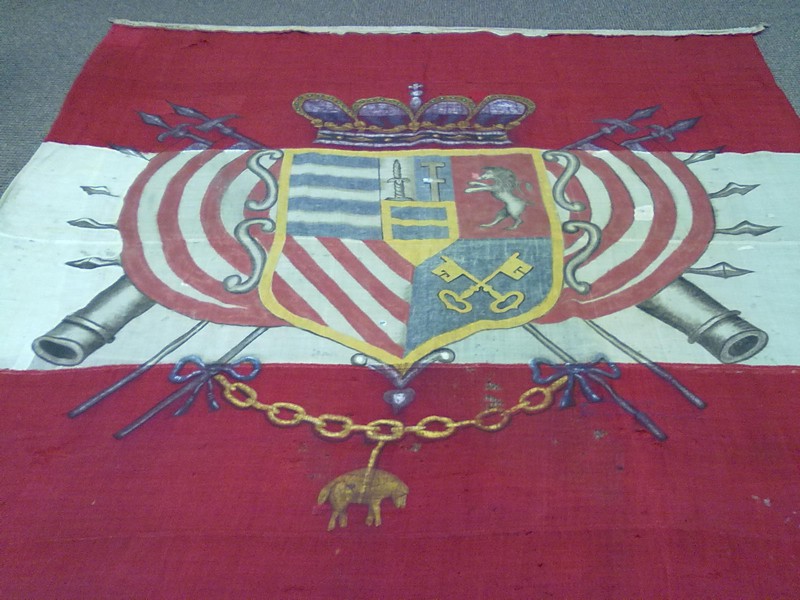 Image from Julie Morton, 11 May 2013
Image from Julie Morton, 11 May 2013
Hi, I work for a costume frame shop in Scottsdale AZ. This antique flag is currently in our shop. I'm wondering if you can help me date it. It's quite large and marked "Tuscan Ensign" on the top border.
Julie Morton, 11 May 2013
It is clearly similar to historical Tuscan flags, but has some significant variations in the coat of arms
Rob Raeside, 12 May 2013
The coat-of-arms surprises me a little, since it shows wrong tinctures. For example:
I had had similar experiences with Spanish 18th century military colours (Habsburg era), spotted in the Museum of Sta. Cruz de Tenerife. There it was the exception that all the quarters had their proper tinctures. Some of them, and of course not always the same quarters, were wrong at least on one of the colours. Thus I am not really surprised.
Klaus-Michael Schneider, 12 May 2013
Thank you for the information. The owner of this flag appreciates it as art. I was curious as to it's possible age. It is safe to say this piece is circa 1840?
Julie Morton, 12 May 2013
According to Arnaud Bunel's site, it appears that coat-of-arms was first used in the grand-duchy of Tuscany when Leopold II of Habsburg-Lorraine (1747-1792) received this polity in 1761 after his father's death as an apanage. The coat-of-arms remained in use until the Italian unification in 1860 (minor the Napoleonic wars period, which came with brand new but quickly outdated coat-of-arms). I don't know when this flag was created, but it was between the end of the XVIIIth and the middle of the XIXth centuries.
I think this is the same flag shown on FOTW: The thing is that the tinctures are wrong, and the guns aren't very clear on our images, but they are on wikipedia's image.
Corentin Chamboredon, 12 May 2013
Oh I see. So it's possible the blues were once purple?
Julie Morton, 12 May 2013
The blue stripes seem too clear to me. I don't think they could have waned in such a manner. If it had been the case, the other colours would even be paler, which is contradicted by their quite bright shades.
Corentin Chamboredon, 12 May 2013
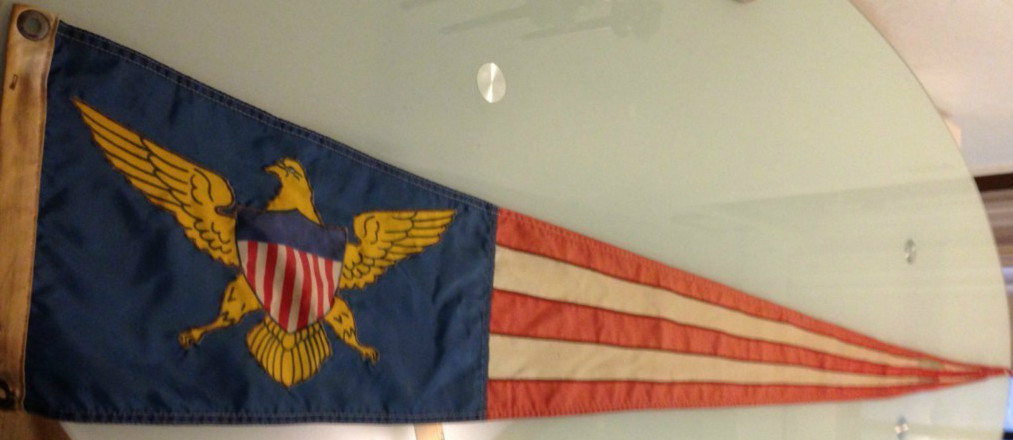
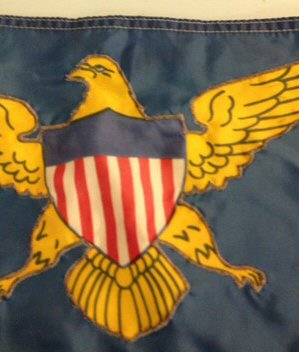
Images from Vicci Mills, 13 May 2013
I am so glad to have found your site and your lists of flag history is quite impressive. After weeks of searching for answers to this flag I was hoping you could help me identify it or provide any leads. It measures 70 inches long. I got it with some yacht burgees and the man who owned them had passed, but served in the marines.
Vicci Mills, 13 May 2013
Regarding the Unknown Eagle Pennant, if you look at the eagle in the hoist of the pennant it is clearly cannibalized from a U.S. Virgin Islands flag. My surmise is that this is an civilian "American" pennant made for a pleasure vessel of the yachting public. Likely someone
wanted an eagle & stripes pennant. It bears no resemblance to any "official" U.S. government pennant. My best guess is some flag maker made this on the cheap by cannibalizing a printed eagle instead of appliquing an eagle from scratch.
Jim Ferrigan, 4 June 2013
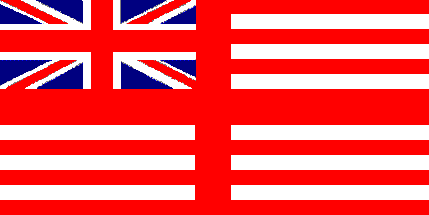
This flag has been identified as the Gridiron Jack of the English India Company.
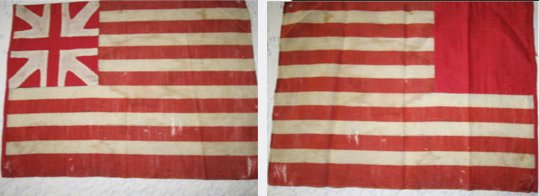
Image from Norman Rozeff, 24 May 2013
My antique merchant brother in Maine cleaned out an estate there. Among the items was an American Civil War era flag of 35 stars. Sewn to one side of it was the flag shown in the attachment. It is not something either of us recognized. Do you know what this flag is and its purpose?
Norman Rozeff, 24 May 2013
I have a few clarification questions to help in the identification process.
The flag is 15" 5/8" by 11 1/2 " the star section measures 6" wide by 5 1/2". With the flag field facing left the cross side is on that side. The back side rear is all red. They are sewn on both the rear and front of the flag covering the stars. The stars are 5 row of 7 stars. It is hand
sewn over the star field and the white section is sewn over the red field like applique. That makes a red cross with the white looking like arrow heads. It is only one flag. So the flag was two sided and then cover up with red and the white put on like applique. I cannot remove the applique without damaging the flag. It was difficult to count the stars. I used a light to back light the field of stars.
Robert Rozeff, 2 June 2013
Someone created a complicated entity with these flags.
Norman Rozeff, 2 June 2013
It sounds like somebody covered up the canton of a 35-star US Flag with a modified British Union on the obverse side and a plain red canton on the reverse side. I continue to suspect a EIC flag.
Pete Loeser, 3 June 2013
Looks like someone making a Grand Union Flag out of a Stars and Stripes. but they haven't added the blue (yet). I could imagine a sympathiser of the United Stated living in the Confederate States to do so to hide his Stars and Stripes. I'm not sure what to think of it if it's from Maine.
Plus, this is not the number of stars from the start of the war, so it would have had to be either made or purchased during the war, or brought up to date, which I also find somewhat unlikely for someone living in the Confederate States.
Maybe it's not so much hiding the S&S, but a post-war project using an outdated S&S to create a Grand Union, with the obverse having been done to the point where they needed blue, and the reverse not having progressed beyond the red field.
It would still be interesting to know what kind of pattern the stars have, though.
Peter Hans van den Muijzenberg, 3 June 2013
One thought that comes to my mind re the above suggestion is that someone might have figured that it would be easier to create a theatrical prop for a revolutionary-era historical drama or pageant by just sewing a new canton over an existing US flag rather than creating a new flag from scratch. Perhaps the planned placement of the prop would not show the reverse. Why no blue in the canton? As Peter Hans suggested, perhaps the projected play or pageant fizzled before the flag was finished or maybe the creator decided it was close enough as it was (it might have been intended to be displayed draped and not fully extented, so the omission would not be so glaring).
Ned Smith, 3 June 2013
 20th Maine Regiment
20th Maine Regiment
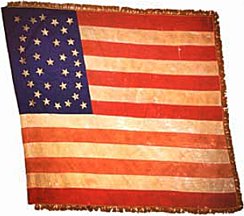 34-Star flag
34-Star flag
While researching information on the 13th and 15th Maine Volunteer Infantry Regiments formed in December 1861 in Augusta, Maine, I started looking for images of the units. They were part of the invasion force here in south Texas in November 1863. By chance I came across the regimental flag for the Maine 20th. It is attached as is a 34 star flag used by a Maine Regimental unit.
I now suspect that what you have is a Maine Regimental flag that had sewn over the regular American one. That would make sense having been found in Maine.
Your sewn over American flag was next in line to the 34 star one shown here.
Norman Rozeff, 19 June 2013
There is another possibility: US Flags, especially hand-wavers like this one (it is certainly not related to any military color given its size) were well overstocked by the end of the Civil War in 1865. Just a decade later the nation was in the thralls of the Centennial Celebration and the so-called "Grand Union" was a very popular flag. Covering up the canton of a surplus US flag is my suspicion but that's all it is. As to the color irregularity, many newspapers published black & white images only. Someone who did not read the print very carefully may have simply made a mistake. Any way this plays very well into Ned's "play or pageant" theory and I agree it is the most likely scenario. I have seen weird flags used in that way before.
In my opinion, there is a zero possibility of it being the East India Co. flag.
Dave Martucci, 21 June 2013
Taking this possibility a step further - if this flag was intended for use in a photo of a Centennial celebration in 1876, then the appearance of the reverse of the canton wouldn't matter and the actual color wouldn't matter in that B&W era.
Ned Smith, 23 June 2013
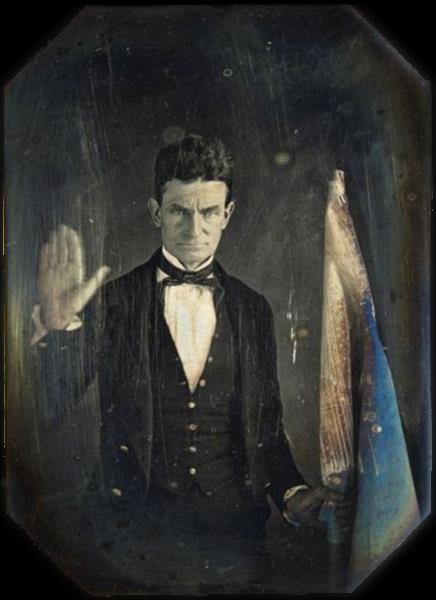 Image from Dan Coppock, 4 June 2013
Image from Dan Coppock, 4 June 2013
I'm doing a bit of an impromptu research project on Union flags in the Civil War. I came across a daguerreotype of John Brown holding a flag of the "Subterranean Pass Way" but you can't see much of the design of the flag. I was wondering if you'd ever come across it or know what it would look like.
Dan Coppock, 4 June 2013
This is a new one for me. I am familiar with two flags associated with John Brown. One claims to be the flag used by John Brown at Harper's Ferry in 1859 and the other was simply a white flag used by a couple of his followers, including a son I believe, who were killed trying to surrender carrying it.
I have never heard of a flag called the "Subterranean Pass Way" flag. It would help if you forwarded a picture of the daguerreotype you are referring to so we have a visual to work from.
Pete Loeser, 4 June 2013
Thanks for following up on this, some ancestors of mine were in the raid and others were involved in the Underground Railroad, so it would be neat to see the standard they fought for.
Here's the picture I came across; and it's the only reference I know of to the flag of the organization, so I don't know how accurate the description of it is.
Dan Coppock, 4 June 2013
I have seen the photo before but just what the flag is, no one knows for sure. The famous auctioneer Wes Cowan states it is the “Subterranean Pass Way” flag in an Auction catalog from December 2007, but does not give any references, so I do not know what that was based on. (photo only)
I have not researched the "Subterranean Pass Way" in any meaningful way so don't know much about it. Frankly, I have studied this photo in the past and never came across the "Subterranean Pass Way" before.
Dave Martucci, 4 June 2013
Although this identifies the flag, does anybody know anything about what this flags design was, or the historical context of the SPW (Subterranean Pass Way)? Apparently it was either a militant version of the underground railroad, or a political organization or party founded by Brown.
Pete Loeser, 4 June 2013
Text from the Wes Cowan auction website: "An oversized plate, housed in a pressed leather case, with a simple purple silk pad, stamped in black Washington Gallery. Hartford CT inside a ribbon surround, and below in block letters Washington Galery [sic]. Hartford, CT. The image framed by a heavy stippled brass, arch-topped mat; the preserver likely from a later 1860s-70s image. The plate itself marked 'O' in one corner.
In the other Washington studio portrait, Brown wears the same outfit and raises his right hand as if taking an oath while he grasps a standard in his right hand. This is the flag of the S.P.W., the 'Subterranean Pass Way,' Brown's militant counterpart to the Underground Railroad In that composition, the lower face and right hand are slightly out of focus with movement as Brown lifts his arm and nods his head forward a bit. It exhibits considerable damage; vertical and horizontal 'wipes' mar the plate in numerous areas. Both daguerreotypes are house in pressed leather cases, each with a simple purple silk pad, stamped in black italics "Washington Gallery. / Hartford CT" and below in block letters 'WASHINGTON GALERY [sic]/ HARTFORD, CT.'"
I´m trying to get a usable image of the flag, and find out a little about the SPW, since only Dave has heard about it before now.
Pete Loeser, 5 June 2012
I looked at those images, but the image is indistinct, colored and flawed so I do not we will ever discern a design for the flag in that image. I have never heard of this organization before, but I will look around.
James Ferrigan, 5 June 2013
Since Brown rejected the pacifist approach of most abolitionists, he wanted to differentiate his more militant strategy from their "Underground Rail Road" and labeled his plans "The Subterranean Pass Way" See Fergus Bordewich's webpage "John Brown's Subterranean Pass-Way" (January 14th, 2006)
From Bordewich's excellant overview:The more I study the circumstances of this photo and the timeline of John Brown's career, the more skeptical I get about auctioneer Cowan's description of it as the "flag of the Subterranean Pass Way." I'm even a bit skeptical of whether it was "John Brown's flag" at all, except in the mundane sense that he was holding it in a well-known portrait.
First, as I already mentioned, the Subterranean Pass Way was a strategy, not an organization. Secondly, even if Brown had decided to produce a flag for his strategy, the plan was a product of the 1850s, while the daguerreotype was shot in the photostudio of Augustus Washington in 1846. Two portraits of Brown were known to have been made by Washington. One was a conventionally posed portrait, the other a portrait seemingly posed to record Brown's militancy and determination. That one included a flag, but there is no evidence to conclude that it was Brown's property, rather than a conventional prop supplied by the studio, or one brought in just for the occasion.
I think we ought to be very cautious in labelling this flag until more evidence surfaces.
Ned Smith, 6 June 2013
Well, it would eventually have been an organisation of people who defended those strong points along its way. Somebody very determined and thinking very far ahead might indeed have created a flag for what was not yet anything more than a one-man movement. So it might be possible.
I'll mention here that I'm not sure whether he's supposed to be swearing by that flag or whether he is forbidding passing on this way, under that flag.
Has Mr. Washington portrayed others in a determined stance? Maybe there are other pictures where this flag shows.
Peter Hans van den Muijzenberg, 6 June 2013
That is certainly true; I don't deny the possibility. It is just that unless more evidence surfaces, it would be rash to assume Cowan's label is accurate. Also, even if the movement in the 1850s did have a flag, it would also be rash to assume it was the same flag shown in the 1846 daguerreotype. And the same would apply to two other organizations led by Brown: (1) the League of Gileadites which he organized in 1850 to resist enforcement of the Fugitive Slave Act, and (2) the guerilla band he led in "Bleeding Kansas" later in the decade.
In referrence to your question about Mr. Washington portraying others in the same determined stance? it is an interesting suggestion and I'll try googling it.
Ned Smith, 6 June 2013
To summarize, at the moment we have identified the flag as one being held by John Brown in the daguerreotype, thus giving it a "John Brown's flag" label, but are unsure that it is connected with his "Subterranean Pass Way" movement, or are even sure of it's exact design (other than looking like a standard used by the period military). It therefore looks condemned to be assigned to my dreaded Sargasso Sea of "Tentative IDs" for the moment, rats...
I will, however, contact Fergus Bordewich, and ask for some of his input to this discussion if he is willing. He is a well-respected expert on John Brown, perhaps he can help with this conundrum.
Pete Loeser, 6 June 2013
For what it's worth, at the secret convention Brown convened in Chatham, Ontario, in 1858 to draw up a provisional constitution for his proposed anti-slavery government of the US, the following was adopted as part of Article XLVI: "...our flag shall be the same that our fathers fought under in the Revolution." [the claim in that article that Brown and his followers didn't seek to overthrow federal or state governments strikes me as a bit disingenuous in light of what is known of Brown's goals]
I did find more daguerreotypes by Augustus Washington online, but nothing comparable to the portrait of John Brown holding the flag. The closest was an image was of Liberian Senator Edward J. Roye being sworn in, but that was either the formal ceremony, or a recreation of it, and no flag was evident. (Source: American Colonization Society at Assata Shakur Forum)
Ned Smith, 7 June 2013
You've got to love "...our flag shall be the same that our fathers fought under in the Revolution," don't you. Let's see, how many one-of-a-type flags would that be...
Pete Loeser, 8 June 2013
Oh, I expect that very few would qualify, unless the fathers of everyone at the convention fought in the same unit. But it's interesting to see that the fathers of all present fought in a war eighty years earlier. I wonder if American wars breed longevity. But indeed, it would be interesting to have an estimate for the number of flags used by the (eventual) United States in their War of Independence.
Peter Hans van den Muijzenberg, 8 June 2013
Well, that depends - if John Brown and his associates were speaking as vexillological scholars the number might be quite high; if they were speaking as members of the 99.9999999% rest of humanity than it would be one... the stars and stripes.
Ned Smith, 9 June 2013
Following further research, unlike my easrlier skepticism I find that Brown apparently did talk of his "Subterranean Pass Way" before the 1850s, although he did no concrete actions to carry it out until later. So he might have designed a SPW flag at the time the daguerreotype was made. That still doesn't mean that is the likely identity of the flag in the image under discussion.
One author, who had met Brown, stated decades later that Brown had an additional daguerreotype made around 1850. This one showed Brown with an African-American, John Thomas, who was holding a "small banneret lettered S.P.W." [John Brown and his Men Richard J. Hinton, 1895, p. 27] Modern scholars have not found evidence of the existence of this daguerreotype and some have reservations about the overall accuracy of many of Hinton's recollections.
For whatever it is worth, if Hinton's claim is true, the flag held by Brown in the surviving daguerreotype would seem to be too large to likely be described as a "small banneret", and whatever design it carried, the most prominent feature on it does not seem to be SPW.
Ned Smith, 9 June 2013
First, I hesitate to give you my definitive opinion on the flag because all my John Brown reference materials are currently in storage, and difficult of access. However, I believe that there is a full discussion of the flag in David S. Reynolds's excellent recent book "John Brown, Abolitionist." It's easily available. Reynolds himself teaches at the CUNY Graduate Center in New York, and should be easy to reach, if necessary.
That said, the flag was not a studio prop. It was a standard with meaning for Brown, and those he sought to lead. The Underground Pass-Way was not a movement; it was a highly speculative plan for militarizing the Underground Railroad, and extending it far into the South. The Harper's Ferry raid was an abortive attempt to put this into action. (Though by the time the raid took place, I think Brown knew the larger plan was unrealistic, and was bent on martyrdom.) I don't think anyone knows what the flag looked like unfurled, but I may be wrong; Reynolds would know.
You are already aware of my essay on the Pass-Way on my website (under the blog). There is also a discussion of the Pass-Way in my book Bound for Canaan, which puts it (and Brown) in the context of the larger Underground Railroad.
Fergus M. Bordewich, 11 June 2013
I looked up David Reynolds´ book on Amazon. With the help of "Look Inside", page 87 notes: "The banner [?] may be inscribed with the initials S.P.W."
Dan Coppock, 12 June 2013
I contacted David Reynolds about UFE13-27 "John Brown's Flag" and he recommended I get in touch with Louis DeCaro, who he identified as an excellent John Brown biographer. I did as suggested and received this reply:
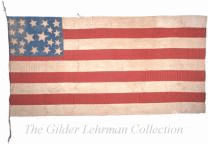 Image from the Gilder Lehrman Collection
Image from the Gilder Lehrman Collection
[Reference the information provided by Louis A. DeCaro, Jr.] If I read this correctly, it means we're seeing the reverse of the flag, mirrored, since it appears to be the obverse, [but] I've not seen anyone else confirming that they saw the "banneret" blazoned with "S.P.W."; could you point out where? If there's information that makes certain that these two dags were from the same sessions, we can be almost certain that we're seeing the SPW banneret; Brown would have had to lug around multiple flags with the intention of having several unrelated dags made, for this to be untrue.
"Banneret" to us has a specific meaning, but the word may merely have been intended to describe a not too large, rather square type of flag.
Peter Hans van den Muijzenberg, 31 August 2013
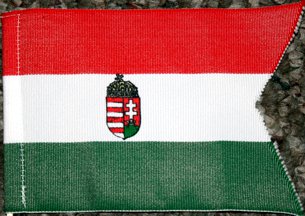 Image from Clayton Horner, 11 June 2013
Image from Clayton Horner, 11 June 2013
A swallowtail Hungarian flag with the arms.
Clayton Horner, 11 June 2013
Obviously a hand-waver, and probably no more, but I have been asked for background.
Rob Raeside, 11 June 2013
Perhaps a tiny flag on the pin as the "staff", worn like a badge? Looks too small, and not flexible enough for proper waving. The surface it is put upon looks like a carpet, or one of those pads the pins are put upon when arranged in a collection.
Tomislav Todorovic, 11 June 2013
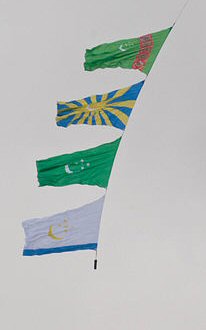 Image from Jose Antonio Jimenez Ruiz, 9 June 2013
Image from Jose Antonio Jimenez Ruiz, 9 June 2013
On Wikipedia [a helicopter tows] what seem to be the flags of the Armed Forces of Turkmenistan. Perhaps from top to bottom: the national flag, the flag of Air Force, the Army flag and the flag of the Navy?. Does anyone have news on these flags? Do [we] have pictures in FOTW-gifs?
Jose Antonio Jimenez, 9 June 2013
Jose is correct and the images can be found on Wikipedia under the Flag of Turkmenistan.
Jeroen van Leeuwen, 18 November 2015
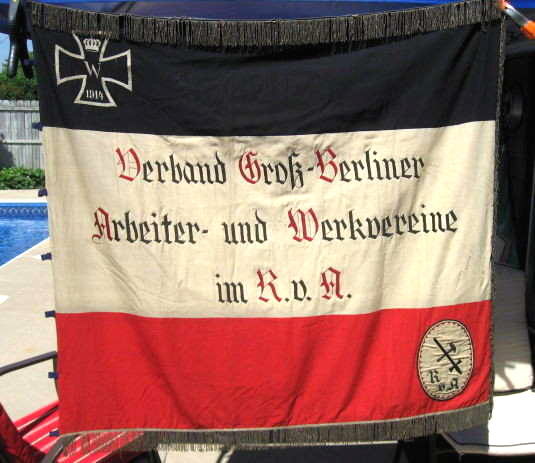 obverse
obverse
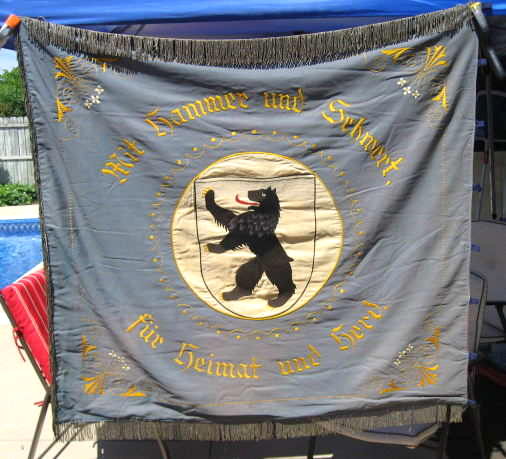 reverse
reverse
Images from William Garrison, June 20, 2013
This was identified as a rare German-Prussian World War I era parade standard on e-Bay. It reads: "This is an original parade standard from the WW1 era (1914-1918) and not a replica or reproduction. It measures approx. 45 x 48 inches and has 8 pole loops. The standard features high quality German bullion embroidery and has silver fringe on 3 sides. There are some small moth holes as shown in the photos. This is a two sided standard and both sides are shown in detail. It is in very good to near excellent condition - great condition for its age." [Details in Question]
William Garrison, June 20, 2013
The SPD celebrated recently its 150th anniversary. But 150 years ago its predecessor was established, a so-called Arbeiterverein. This flag is probably affiliated with the German Labourers´ Movement. As the colours are black-white-red, I am in doubt, whether its from the 1920s. I guess, its older. In case of doubt, ask Marcus! He is the specialist in party flags.
Klaus-Michael Schneider, 20 June 2013
Definitely far from SPD! Although I am (kind of) a specialist in party flags, this does not refer to individual flags of the Weimar era, such as this one.
The "RVA" refers to the Reichsbund vaterländischer Arbeiter- u.
Werkvereine, a right-wing workers' association close to the right-extreme DNVP, thus the black-white-red.
I do not find much online about the RVA, especially Wikipedia lacks an article on it. As far as I understand, the RVA was founded in 1924; probably dissolved (gleichgeschaltet) in 1933.
A similar flag can be found on the Stadtgeschichtliches Museum website in Leipzig
Marcus Schmöger, 21 June 2013
It's a square banner with a fringe along three sides. The front has three horizontal stripes black-white-red, approximately 2:3:2. In the upper hoist, within the black, is a white outline of an iron cross, bearing in white, from top to bottom, a crown, a "W", and a year. The latter looks like 1914, but I lack the necessary detail.
In the white the text "Verband Groß-Berliner Arbeiter- und Werkvereine im R. v. A." (wtq) [sz]. The text in red, except for the capitals in red, and those also written or drawn with internal decoration in their loops.
In the lower fly, within the red, a white oval badge with a dotted border along its edge, which may well be stitching. Low in the badge are the letters "RvA"; but the main content is a black mark that at first appears to be a German rune or a house mark, but which actually is a hammer and sword crossed in saltire. This most likely refers to "Hammer und Schwert" - Hammer and Sword - referring to a joint community that includes both workers and soldiers. As such it's a symbol from the political left, end(?) of the second decade of the twentieth century, but in the course of the next decade was used more by right wing organisations and at the end of that decade became a symbol of the Hitler Jugend.
This, the organisational side, is the same for the Leipzig version [the photograph of which we should probably appropriate for easy comparison, if the museum doesn't mind], except that the text there is "Reichsbund vaterländischer Arbeiter- u. Werkvereine e. V. Bezirksverband Leipzich". Apparently the Leipzich branch is a direct part of the RvA, where the Greater Berlin branch is a separate organisation within the RvA.
The unit side of the UFE is blue/grey, with centered the shield of Berlin on a white spanning disk with a narrow gold border. Around that runs a decorative gold border, and on the outside of that two arcs of text in gold: The upper text is indeed "Mit Hammer und Schwert, (wtq); the lower text continues this with "für Heimat und Herd." (wtq) [u"]. So, in all: With hammer and sword for home and hearth. (Heimat/Home is probably to be understood in its sense of "homeland", whereas the Herd/Hearth refers to the individual home.) Another gold border follows the rectangular shape of the flag, with in its corner multi-coloured decoration that I can't see clear enough to determine whether they are more than just bunches of pretty flowers.
The unit side of the Leipzich version is similar in structure, but the field is the Saxon Green over White, it has the Leipzich shield, and the texts are "Für Deutschtum, Tapferkeit", (wtq) [u"] and "Wahrhaftigkeit und Treue." (wtq), plus horizontally on the left of the disk "1912" (wtq) and in the right "1927" (wtq). So: "For Germanness, Bravery, Truthfulness and Loyalty". And the dates appear to indicate fifteen years since a 1912 foundation. Since we don't know why the Saxon colours were sometimes Green over White and sometimes White over Green, the order of the colours probably doesn't help us much. Considering the Leipzich version has the Saxon colours, the Berlin version may have Prussian blue.
Peter Hans van den Muijzenberg, 25 January 2016
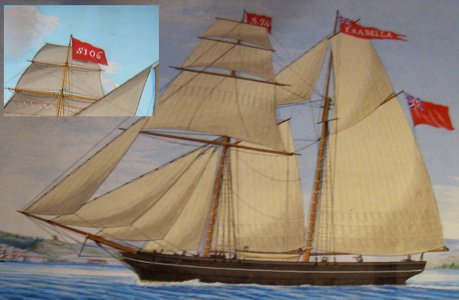 Image from Roger Barrett, 20 June 2013
Image from Roger Barrett, 20 June 2013
Can you help me please? I'm the Chairman of Salcombe Maritime Museum in Devon, England. In the museum we have a collection of paintings of Salcombe-built schooners. Many of them display a flag on the foremast as shown on the attached photos. The flag is red and rectangular and in all cases has an S followed by a number e.g. S106. Do you know what the flags signify?
Roger Barrett, 20 June 2013
I guess the red ensign should not be discussed. On the mizzen mast there seems to be a name pennant resp. a name flag. On the great mast there is a number flag. Such number flags were used by German ship owners for insurance purposes and inorder to be identified by passing ships. This happen in times, when there didn´t yet exist proper house flags of the ship owners. As far as I know, a special ship had no proper number. The number flags only were given for just one sail (and perhaps back).
Klaus-Michael Schneider, 21 June 2013
The painting of the Isabella can also be found in high resolution where it is captioned: "Isabella of Salcombe, J. Evans Master
entering Smyrna, 1853". The painting does indeed show a red rectangular flag, approximately 2:3, with a red field and in white the text "S.74", and the other example in the image has "S106", but is otherwise identical.
Flags like these are registration flags. Their characteristics are that they have a specific pattern, in this case apparently 2:3, red, white letters and a code starting with S, to which for each individual registration a registration number is added, here "74" and "106".
What kind of registration they indicate differs between places and times, but often they indicate registration of the ship's (maybe even trip's) insurance, or membership of the owner or master in a mutual insurance organisation.
Salcombe did indeed have a mutual insurance, founded in 1811 or 1831. (On the Internet 1811 is more popular but that's because it's in the hundred-fold copied text of Wikipedia.) I don't know what happened to it, but it's likely that it existed at least until the steamships became an economically superior alternative, probably in the last quarter of the 19th century. Since we now have 1853 as an example date, this Salcombe mutual insurance would seem a likely register for this flag.
I expect Roger Barrett has access to local archives and can more easily determine the time frame of the mutual, and whether registration numbers match members lists. I hope we'll hear from him whether this will lead to a successful identification.
Peter Hans van den Muijzenberg, 1 September 2013
I am extremely grateful to you for your very helpful message. You certainly seem to have solved the mystery! Unfortunately, we do not have a lot of information about the Salcombe Shipping Association - apart from annual reports published in local newspapers. These are only very short summaries of the annual meeting held every June in a local pub. There are no references to flags issued by the association. However, I have looked at the pictures we have of Salcombe ships bearing flags of this type and, with one exception (Nellie) the ship's launch date ties in chronologically with the numerical sequence of the flags:
Flag Number |
Ship Name |
Year Launched |
S27 |
Jessamine |
1839 |
S31 |
ED |
1839 |
S41 |
Dolores |
1841 |
S42 |
Lady Courtenay |
1842 |
S69 |
Cynosure |
1847 |
S73 |
Fanny |
1850 |
S74 |
Isabella |
1852 |
S87 |
Prothesa |
1855 |
S97 |
Susan |
1857 |
S105 |
Ernest |
1858 |
S106 |
Clara |
1858 |
S122 |
Willie |
1860 |
S126 |
Nellie |
1867 |
S127 |
Marian |
1861 |
S130 |
Huntress |
1862 |
S133 |
Erme |
1863 |
S150 |
Restless |
1865 |
S151 |
Island Maid |
1865 |
S158 |
Caroline |
1866 |
S162 |
Annie |
1867 |
S166 |
Peggy |
1868 |
S168 |
Zenobia |
1868 |
S171 |
Leader |
1869 |
S180 |
Morning Star |
1871 |
Perhaps Nellie was issued with the code number of an earlier ship that had been lost? The date range is, as you can see, from pre-1839 to 1872. The Shipping Association, usually referred to as the "Salcombe Club" was formed in 1831 and wound up about 1883 when the building of wooden sailing ships largely came to an end in Salcombe. This all seems to confirm that the flag with its "S code" was unique to Salcombe - presumably the "S" stands for Salcombe?
For your information I have attached a list of ships in the Exeter Shipping Association between 1838 and 1844. The penultimate column gives the flag no. of each ship in the "club". The image has been scanned from Vol 2, p100 of "The New Maritime History of Devon", Conway maritime Press, London, 1994.
Roger Barrett Chairman, Salcombe Maritime Museum, 5 September 2013
In an article regarding the Pakistan Air Force JF-17 aircraft a picture shows five Pakistani military flags, but only two can be recognized at least optically (on the background, left). The whole picture shows "A JF-17 on display at the IDEAS 2008 defense exhibition in Karachi, Pakistan" (November 24-28). One can also see the flags in a video titled "JF-17 Thunder & Pakistan Nuclear Missiles at IDEAS 2008" and similar flags can be seen at: Military Photos Net forum (see photo here) and the Pakistan Aeronautical Complex forum (see photo here).
Esteban Rivera, 24 June 2013
 Image by Peter Hans van den Muijzenberg, 9 July 2013
Image by Peter Hans van den Muijzenberg, 9 July 2013
Could you please tell me what country or entity, if any, has an orange and green bicolor flag with no other emblems on it? The (one) orange bar and (one) green bar are vertically divided. Also, the orange bar constitutes 1/3 of the flag and the green bar constitutes the other 2/3. There is no white on the flag.
Cathy Nelson, 6 March 2012
I fear I have no direct answer. To the best of my knowledge there's no country flag with a design matching the above. The closest I could think of is a pattern that is rather red and green, the arms-less version of the flag of La Matanza de Acentejo in the Canary Islands. However, to visualise the design, and to allow Cathy to confirm or correct my interpretation of "vertically divided", I drew a version of this design.
I'm also curious about what prompted this question. Is this flag depicted somewhere, was it flying somewhere, has it flashed past on TV? That also might give us an idea of where to look for this flag. Or is the question merely intended to determine whether the pattern is unused or not?
Peter Hans van den Muijzenberg, 9 July 2013